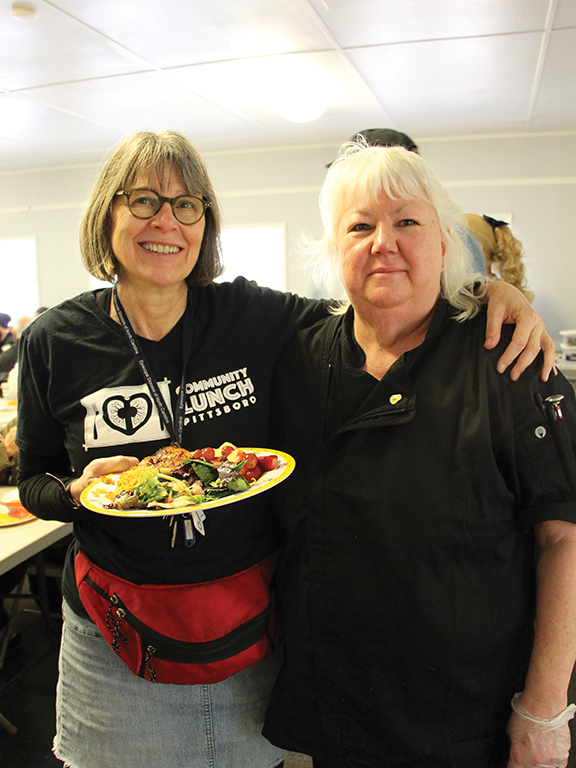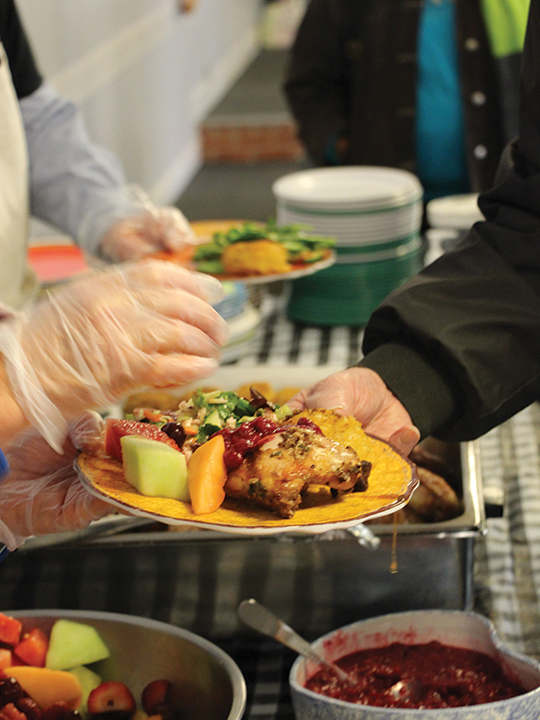Disciple: Community Lunch

One church’s offering becomes a county-wide collaboration
By Christine McTaggart
If one is looking for inspiring ways to enter into missional collaborations as a means of Becoming Beloved Community, they need only look to St. Bartholomew’s, Pittsboro, to see a community collaboration come to life.
Every Thursday for 10 years, St. Bart’s has hosted Community Lunch, an offering that didn’t break down community barriers so much as refuse to put them up in the first place.
“You are a stranger only until you walk through the door,” said Karen Ladd, lay minister at St. Bart’s and the founder of Community Lunch. “This is the only place I know of where people from all walks of life sit and break bread together and build bridges in the community.”
IF YOU BUILD IT….
Community Lunch began as an idea of Ladd’s, who had experience as a volunteer in other food programs, including Shepherd’s Table at Good Shepherd, Raleigh. When she approached the vestry of St. Bart’s about serving food to the local community, she explained her vision and how her approach was a bit different. She wanted to provide a meal to which everyone was invited, and while the target population would include people struggling with hard times, she wanted the offering to build bridges among all the strata of Pittsboro. Keeping with St. Bart’s long history of social ministry, the vestry approved the idea, and Ladd went to work. The first few months saw lunch served only once per month, but it was soon offered once a week. Ladd served as chef, promoter and host, and as the luncheon quickly built momentum, she reached out to friends to ask if they would be interested in helping with the cooking. As a core group of chefs developed, Ladd ran ads in the local paper explaining the Community Lunch concept, asking for volunteers and inviting all who wanted to attend. She extended the invitation in person, too, walking through neighborhoods and putting up posters in downtown Pittsboro. It didn’t take long to see the results. “It just grew like wildfire,” she said.
At first, most of the food served was purchased, with some donations coming in to supplement. But when word started to spread through the community that the weekly luncheon did, indeed, live up to its name, the community began to get involved.
“We’re lucky in Chatham County to have some really wonderful local organic growers,” said Ladd. “They came on board. Vendors at the local farmers market started to bring to us product left over at the end of the day so it could be put to good use.” Other farmers came forward, and soon Community Lunch was collaborating with Farmer Foodshare, a nonprofit organization that “connects people who grow food with people who need food.”
A local resident donated deer meat he had in his freezer, while others brought cakes and pies (they still do). Two Methodist churches started bringing desserts as well, and several local bakeries now donate bread and other goods every Wednesday in preparation for Thursday lunches. The more people got involved, the more word spread, and the more word spread, the more the number of folks involved grew.
“[People] like to do things for others,” said Ladd. “That’s the Body of Christ. This has really become sort of a beacon where people can find a place to help out and to be friends and really to be community.”
THE NEXT LEVEL
 Within a few years, Ladd found her pastoral duties increasing, making it hard for her to maintain all the Community Lunch roles she had played since the start. She relinquished her cooking duties, and they were assumed by a local farmer with cooking experience. He stayed with the ministry for another couple of years, and then K.T. Leary came to town.
Within a few years, Ladd found her pastoral duties increasing, making it hard for her to maintain all the Community Lunch roles she had played since the start. She relinquished her cooking duties, and they were assumed by a local farmer with cooking experience. He stayed with the ministry for another couple of years, and then K.T. Leary came to town.
Leary was new to North Carolina in 2015, having recently moved from Massachusetts. A professional chef, a chance request led her down what would become an incredibly fulfilling path.
“One day my sister-in-law asked me to get my brother out of the house and suggested a visit to St. Bart’s,” Leary remembers. It was on that visit she learned about Community Lunch. “I’m not an Episcopalian,” she said. “But I believe in community and the teachings of Jesus, and I believe in the message of being a force for good. The Community Lunch fit that for me.”
When she walked into the kitchen and learned no professional chef had ever held a leadership role in the ministry, she saw the potential her experience could enrich and develop. Leary knew she could contribute more than a love of cooking, so she went to work increasing the donor list and building a wider network within the community. Her goal was to seek out other organizations with feeding programs to develop mutually supportive relationships. She met that goal and more.
These days food comes from a multitude of sources: other churches, food pantries, the local community gardens – all of it high quality, all of it healthy. But what’s been built isn’t just a donor list, it’s relationships. As food comes in to St. Bart’s for Community Lunch, so does food go out once lunch has been served. Unused bread or extra food might be offered on a table for those in need to take home, while other, more perishable or hard-to-store items are shared with the local firehouse or Habitat for Humanity chapter. For Leary, the equation is simple.
“The more we have,” she said, “the more we are able to provide.”
NO STRANGERS
“Everyone is invited,” said Ladd. For those who accept the invitation on any given Thursday, the Community Lunch itself lives up to its name.
The more than 125 weekly guests are greeted at the door by volunteers, who offer a warm welcome and a quick orientation on the flow of the meal. People from all walks of life come to share the experience; it’s not unusual to see those on lunch breaks from their jobs deep in conversation with those who don’t have a home. For a brief span of time, labels are set aside.
“We don’t make people self-identify as poor,” said Ladd. “So nothing we offer is received as charity. Everyone sees it as community, and everyone feels welcome and beloved.”
“It’s just a beautiful couple of hours,” adds Leary. “When you walk in the door, it’s noisy and joyous. There’s a lot of individual commitment to having a loving meal together, and it’s a chance to sit and talk with someone you might otherwise never get a chance to share a meal with.”
Part of the feeling surely comes from the open welcome and lack of labels. Part of it certainly has to do with the savoring of food that is regularly judged “delicious” and menus that might feature dishes such as chicken with a light cream and pesto sauce or an Indonesian red-lentil dal with baby kale. And part of it is the result of the tireless efforts of the volunteers, about half of whom are St. Bart’s parishioners, half of whom come from the surrounding community, and all of whom do whatever is needed.
“Volunteers are just everywhere and pitch in,” said Leary.
“At Community Luch,” said Ladd, “no one is ‘less than.’ We’re all equal.”
A COMMUNITY CONNECTOR
 The impact Community Lunch has had on its surrounding community cannot be measured, but it is easily seen in the relationships developed over the years and the collaborations that continue to find new ways to work together.
The impact Community Lunch has had on its surrounding community cannot be measured, but it is easily seen in the relationships developed over the years and the collaborations that continue to find new ways to work together.
When a local Presbyterian church wanted to offer racial equity training but did not have enough space to do so, St. Bart’s offered their parish hall. Other churches joined the partnership to spread the word about the training and increase the number of participants.
Later when renovations started on that same St. Bart’s space, the local Kiwanis club reached out to offer their “hut” for the weekly luncheons. The Seventh Day Adventist Church, also a key contributor of food — including the key proteins like meat, butter and cheese — offered to share their sanctuary as a worship space.
A St. Bart’s community garden was a natural offshoot of Community Lunch and a way to grow some of the needed food, but it also became a collaboration between the ministry and the local YMCA, whose day campers come to the church and tend the garden.
And in the kitchen of Community Lunch, you’ll find youth volunteers, the result of a partnership the ministry developed with Chatham Community in Schools, an organization that finds opportunities for children who have court-mandated community service to fulfill. Those who come to the ministry may not have skills or know what to expect, but what they find is what everyone who walks through the doors finds: love, acceptance and a genuine welcome. And once Leary begins taking them under her wing, her mentorship provides them with useful skills and a place where they realize they are valued.
ALL ARE WELCOME
Between the growers, the organizations, the churches, the nonprofits, the volunteers, the guests and more, it’s easy to feel as though there’s not a Chatham County connection that hasn’t been made with Community Lunch. The ministry has become a focal point for a community where everyone is truly welcome and invited to be a part of it.
At the heart of the collaboration is an understanding that people are not owners of community, they are a part of it. For those who want to become a community connector themselves, Ladd advises, “Often when outreach projects are started, the people starting it think they know what the community needs instead of asking the community what it needs. Listen carefully. Step back when need be. Let the needs direct the outreach.”
In creating that space, you may find unexpected ways to do the work of God.
“Earlier this year, a couple of Methodist ministers came for lunch and said to us, ‘What you’re doing here is church,’” said Ladd. “And it’s really true. We sit down as the Body of Christ — broken and blessed, and we break bread together. We are a community, and we mean it when we say everyone is invited.”
Christine McTaggart is the communications director for the Diocese of North Carolina.
Tags: North Carolina Disciple
